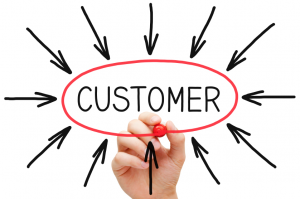Copied from a recent guest blog post that I did recently for Simon Cooper from KUPR Consulting.

2018 sees us well and truly in the age of the customer and we’re seeing more and more organisations rethinking about where their growth comes from and about the right level of investment needed in their customer facing teams (not just Customer Success). Customer Success continues to grow as a way of working, as a discipline and as a new exciting career option – the role of a Customer Success Manager has been the number one advertised job on LinkedIn in a number of different countries around the world.
With this growth, the need for very good Customer Success leadership is becoming more and more critical, to ensure we’re delivering the necessary outcomes for and growing value to our customers.
I’ve worked with and within a number of different technology organisations – both startups and global enterprises – and each has its own unique challenges and circumstances but with a number of common key themes.
Why is being customer centric important at the leadership level you might ask?
It’s not only the obvious, i.e. that your customers stay loyal when they have good experiences and when product and sales are delivering on our promises, but also as our customers keep evolving and changing, so too are the ways that we operationalise this and how we support our customers. You become customer centric when you deliver on-going growing value to and for your customers.
But it’s not just about having a Customer Success team and having Customer Success managers in our companies. Having a Customer Success leader gives you:
- Visibility – to see what is happening to your customers
- Clarity – to understand the changes when a prospect becomes a customer
- Balance of power – the third pillar for focus (alongside sales and operations)
- Sales focus – sales focused on new business with no customer distractions
- Feedback – understanding what is really happening outside of the business
- Signalling – that critical external messaging that we are customer centric
I had the privilege of co-hosting a webinar recently with Jason Whitehead (the CEO and Founder of Tri Tuns) where we talked through some of the key questions around Customer Success leadership. Some of these are covered below – you can also find the webinar recording and details of other ones in this series here.
The challenges today
There are some amazing Customer Success leaders internationally and I’m lucky enough to know a good number of them (and I’ve learnt so much from them) but there are some big challenges that we’re facing. I’m going to look at a number of these now.
(1) Lack of Customer Success experience – it is a new and fast changing area, and there just aren’t leaders around with long track records in this world called Customer Success. That’s not to say there aren’t leaders with solid world class experience in customer facing roles but it can make finding the right person more of a challenge and require a wider search. This can be seen especially when we need more strategic thinking and planning.
(2) Customer and business maturity – the vision of what Customer Success means to a business depends on your own organisation and your specific customers. Sure there are guidelines and principles that are consistent, but our own maturity and stage as a business can and does impact what we want from Customer Success and our Customer Success leader on day one or even day 501. We may be in a stage where our Customer Success team are acting as firefighters in a more reactive position than driving new value and outcomes with customers more proactively, and the key is understanding this and where we are now. The maturity of our customers is also important to understand and by this I mean where they are in their own stage of growth, their overall adoption of new technology services and their expectations from our services.
(3) Investment being made into sales not Customer Success – for a lot of businesses, sales (in terms of new business) is still (seen as) the main growth engine and not the existing customer base. As businesses grow and expand and extend their services and offerings this is changing but it requires a shift in mindset for our CEOs and founders. This investment includes our Customer Success leader, our Customer Success managers (with different levels of experience) and potentially other Customer Success roles.
(4) Expectations for industry specific knowledge – this continues to be a growing challenge where organisations are looking through multiple lenses when hiring their Customer Success leader and looking for very specific industry and even technology experience, as well as solid experience in Customer Success and other customer facing roles. Many Customer Success leaders are amazing business generalists, and well skilled in working well in many different industry verticals and with broad (rather than deep) technical skills.
(5) Short tenures – a number of the challenges above mean that many Customer Success leaders have had to move around in different organisations and whilst this has given a solid benefit of broad experience it can be seen as an issue. I’d always encourage good conversations with my Customer Success leader candidates to understand the drivers behind different positions and moves, and not simply put this as a blocker (which it often is).
(6) Are we a customer centric business? I don’t believe there are organisations who would say that they weren’t all about their customers but without the necessary customer focus and thinking at a strategic level, our Customer Success leader and team will not function and deliver as we need them to.
What makes a great Customer Success leader?
There are three traits that I believe are critical in great Customer Success leaders and strangely enough these are the same three traits I look for in new Customer Success managers joining my teams:
-
Passion – a level of drive and motivation about your values and Customer Success
-
Empathy – for customers and their teams and companies
-
Broad technology and industry experience – broad not deep
Yes these are quite broad but they are at the essence of what Customer Success is. The last one I really like, as I think the breadth of experience in multiple customer facing roles and with different companies and technologies is a differentiator. You need to understand the bigger picture with your customers and where you and your company’s service and/or technology fit in.
A couple of other important things to add are:
- Experience growing and scaling teams and businesses
- Customer focus (of course)
- Being bold – you’ll need to try new ideas and influence change
- Being agile and not averse to change (or managing change)
- A like for processes is a must have – you’ll have to define and build new frameworks and ways of working (and these have to keep evolving as your customers do)
- You are the ultimate voice of the customer – and that can be a lonely place but you need to be there and you need to bring the customer (voice of and feedback) into every meeting
- When you start, go and meet (all) your customers – hear what they’ve got to say
- And Customer Success leaders often also take on responsibility for certain key accounts and there is no better way to learn
Does the title matter?
Yes and no. It really depends on the organisation and titles can and do vary. You may be head of Customer Success, director of Customer Success, VP of Customer Success or even the new chief customer officer (which as the newest member of the C-suite I’m happy to report that we’re continuing to see more appointments of this level).
Customer leadership is often the missing piece when companies look to be more customer centric – irrespective of the title, the role is all about increasing customer value and bringing the customer conversation to the board level. You need to be ultimately responsible for your company’s customer relationships.
Are there any differences in Customer Success leadership globally?
On the whole no – you need the same core skills, core traits and type of customer focused experience, and you will be working to and driving a similar vision and approach. There are of course the more subtle (or not) cultural differences and as you grow and expand the teams and regions you work in, you need to be very conscious of these – both for your teams and your customers.
Local language is so important as well – look at Europe as a great of example of this. I’m always a fan of having local language people in the local region to help drive value and better outcomes for my customers.
I always talk about differences with the likes of NPS and this is a good example I think of where you, as a Customer Success leader, need to be aware of potential cultural differences. We all know that only a 9 or 10 rating on an NPS results in it being classed as a promoter. Our US based friends and colleagues might often give 9’s or 10’s as ratings but in the UK – and I hope I’m not generalising – 9 or 10 is better than excellent and very, very rarely happens. That’s like 100% in an exam. A 7 could be a very good score but that only means your passive in the world of NPS. This changes how you might view the scores that you get, and where your true baseline is.
You are the voice of the customer
We all know that our customers are already talking to other customers and future prospects, – I want them to say the right thing!
It’s critical to build and to lead a voice of the customer programme. You, as the Customer Success leader, need to be constantly and consistently listening to and hearing what your customers are saying and then empowering your teams and companies to take actions.
There is a huge ROI in finding out what went wrong (and yes things always do go wrong) and fixing it and letting our customers know we’ve listened and what we’ve done.
Where do I find them?
I’m going to close off this blog post with this final point. We all know that Customer Success as its own separate formal discipline is relatively new and so, by definition, they aren’t many people with many years experience in the actual role itself. But that’s not to say that there aren’t some amazing Customer Success leaders in the industry around the world. Many come from other customer facing roles and even from multiple customer facing roles (and leadership roles). Some great examples include customer support, professional services and consulting, project management, service delivery, account management and sales roles. All of these roles bring some fantastic experience with them – from building and growing customer relationships, delivering value and outcomes, and handling difficult and challenging customer conversations.


















